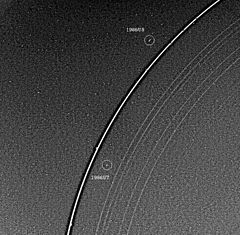Cordelia (moon)

Cordelia (lower-middle, inside of bright ring), discovery image from Voyager 2
|
|
| Discovery | |
|---|---|
| Discovered by | Richard J. Terrile / Voyager 2 |
| Discovery date | January 20, 1986 |
| Orbital characteristics | |
|
Mean orbit radius
|
49751.722 ± 0.149 km |
| Eccentricity | 0.00026 ± 0.000096 |
| 0.33503384 ± 0.00000058 d | |
| Inclination | 0.08479 ± 0.031° (to Uranus' equator) |
| Satellite of | Uranus |
| Physical characteristics | |
| Dimensions | 50 × 36 × 36 km |
|
Mean radius
|
20.1 ± 3 km |
| ~5500 km² | |
| Volume | ~38,900 km³ |
| Mass | ~4.4×1016 kg |
|
Mean density
|
~1.3 g/cm³ (assumed) |
| ~0.0073 m/s² | |
| ~0.017 km/s | |
| synchronous | |
| zero | |
| Albedo |
|
| Temperature | ~64 K |
Cordelia (/kɔːrˈdiːliə/ kor-DEE-lee-ə) is the innermost known moon of Uranus. It was discovered from the images taken by Voyager 2 on January 20, 1986, and was given the temporary designation S/1986 U 7. It was not detected again until the Hubble Space Telescope observed it in 1997. Cordelia takes its name from the youngest daughter of Lear in William Shakespeare's King Lear. It is also designated Uranus VI.
Other than its orbit, radius of 20 km and geometric albedo of 0.08 virtually nothing is known about it. In the Voyager 2 images Cordelia appears as an elongated object with its major axis pointing towards Uranus. The ratio of axes of Cordelia's prolate spheroid is 0.7 ± 0.2.
Cordelia acts as the inner shepherd satellite for Uranus' Epsilon ring. Cordelia's orbit is within Uranus' synchronous orbit radius, and is therefore slowly decaying due to tidal deceleration.
Cordelia is very close to a 5:3 orbital resonance with Rosalind.
Explanatory notes
Citations
...
Wikipedia
